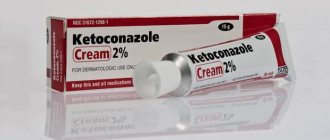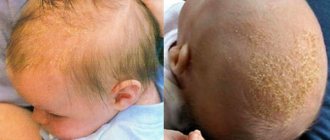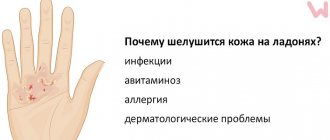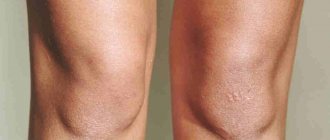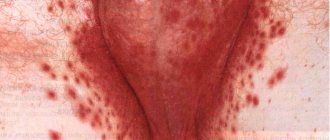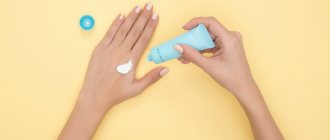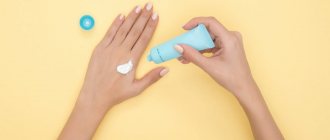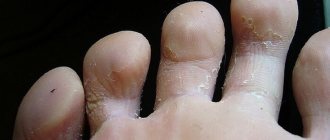August 16, 2021
Peeling on the hands is a signal that the skin is not hydrated enough. In diagnostics, this sign is called “xerosis.” The causes of dry and flaky hand skin are not always pathological. Often this only means that you need to change your household habits. If the discomfort does not go away for a long time, the symptoms increase, you need to contact a dermatologist for an examination.
The child's palms are peeling. Why does the skin on the palms of the hands peel?
There are many reasons why palms and fingers peel and peel. It all depends on the individual, his skin and occupation. One of the main ones is an allergy to:
- cold;
- caring cosmetics – creams, ointments, soaps, etc.;
- food consumed;
- medicines;
- dishwashing detergent, especially if used frequently without gloves.
Another reason that the skin peels is the lack of proper hand care, including insufficiently deep moisturizing. This is especially true for those who have naturally dry skin. From a lack of vitamins, peeling of the epidermis is also often observed. With a deficiency of microelements, the elasticity of the skin decreases, which can cause cracks. Vitamin deficiency occurs in autumn or spring. In winter, peeling is a consequence of exposure to cold. Among the more general factors that cause peeling are:
- prolonged exposure to the sun;
- dry air during the heating season or hot period of the year;
- the habit of constantly scratching your palms, which causes infection in the tissues;
- contacts with cement, dust, earth and other construction work.
A separate reason for peeling skin is a fungus. In this case, the manifestation of symptoms along the edges of the palms is especially characteristic. If the skin on the palms and other parts of the hands peels off, this may indicate some other diseases, such as:
- eczema;
- dermatitis;
- psoriasis;
- lichen planus;
- scabies (the skin peels off on the palms and between the fingers).
In this case, not only does the skin peel off, but also itching, redness and a rash appear. Changing cosmetics will not help here. Treatment is carried out after tests and can only be prescribed by a doctor. In addition to skin pathologies, the reason that the skin peels off is also diseases of the internal organs, parasitic, infectious, etc.:
- lupus erythematosus;
- parakeratosis, hyperkeratosis;
- syphilis;
- staphylococcal infections;
- scarlet fever (fingertips peel off);
- helminthic infestation;
- dehydration (skin peels off, hair becomes dry);
- stress and neurological disorders;
- pathological processes in the pancreas;
- hormonal imbalance;
- reduced immunity.
The skin on the palm of one hand is peeling
The reasons why the skin peels off on the palm of one hand are the same as in the case of both hands. Although more often this phenomenon is observed in the event of contact with this hand of some kind of irritant. This is how an allergic reaction to detergent, cosmetics, food, sun or dry air manifests itself. Skin diseases can also be the cause of peeling palms. Often psoriasis or lichen appears on some parts of the body, and not necessarily on both arms. Lack of vitamins is also a factor in the fact that the skin begins to peel off.
The skin is bursting
A more serious problem is skin popping. It may be more painful. Among the external reasons for this phenomenon are:
- exposure to frost;
- aggressive household chemicals;
- unsuitable cosmetics;
- contact with solvents, paints and other compounds used during repairs.
There are a number of diseases that lead to the skin on the palms or arms in general bursting and peeling off:
- eczema;
- avitaminosis;
- fungal infections;
- psoriasis;
- dermatosis;
- metabolic disease;
- hormonal imbalances;
- heredity;
- taking antibiotics;
- inflammation in the body.
The skin on the child’s hands is peeling
In young children, peeling skin on the palms of the hands is often a consequence of vitamin deficiency, reduced immunity, or hormonal imbalance. For children, this condition can be very dangerous, so you should immediately consult a doctor. Preschool children have a habit of scratching their palms, which also leads to peeling palms. When peeling is combined with a rash and redness on the face, a child may be diagnosed with dermatitis.
Rough spots on a child's body
- The appearance of rough patches of skin is a fairly common phenomenon among children in the first three years of life. If you find rough spots with a small reddish rash on your child’s body, most likely you are dealing with atopic dermatitis
- At the same time, in the morning while sleeping, the rash may be invisible and dry, rough skin can only be detected by touch. Spots may appear on different parts of the body, most often on the cheeks, arms or legs. During exacerbations, particularly in winter, the spots become irritated, red and raised
- Atopic dermatitis may be caused by a hereditary immune system that reacts to allergens in food and the environment, as well as a genetic predisposition to dry skin
- Atopic skin needs special care and hydration. In addition, an important role is played by the need to eliminate the allergen, follow a diet and carefully select cosmetics, clothing and everything that comes into contact with the child’s skin.
More information about atopic dermatitis can be found in the article Diet for atopic dermatitis in a child. Modern and traditional treatment of atopic dermatitis in children
Rough or dry skin can also be a consequence of dry air, chlorinated water, abuse of herbal decoctions when bathing, lack of moisture in the body, etc.
A 6 year old child has peeling palms. Palms are peeling - what to do?
Children's bodies are fragile and susceptible to all sorts of harmful influences.
This is especially worrying for mothers. However, do not panic if your palms begin to peel.
Causes
Since the baby’s immunity has not yet developed, any aggression in the atmosphere can cause a surprise. What causes skin to peel? It is worth listing just a few possible reasons:
- Fungal infection;
- Lack of vitamins;
- The appearance of diaper rash;
- Stress;
- Allergy;
However, there is no need to panic; it is better to consult a pediatrician who will prescribe an examination. Although some mothers do not trust them, trying to independently determine the reason. This also makes sense, so it is worth exploring the causes of peeling palms in more detail. First of all, you need to find out everything about it - after all, this is also possible.
Lack of vitamins
Not all vitamins consumed are completely absorbed by the child, especially those purchased in pharmacies. Therefore, mothers should understand what vitamins the baby lacks in order to take urgent measures.
Lack of vitamins is sometimes caused by past illnesses. Parents notice that a cold can cause complications such as peeling of the palms. Restoration of the body, good nutrition, and lubricating the palms with baby cream are required.
Fungal diseases
Any child is inquisitive, he wants to check everything with his hands. Mothers are not always able to ensure that the baby does not stroke other animals in time. And there are many other opportunities to pick up a fungus, since the child is very actively learning about his surroundings.
It is worth knowing that the fungus is transmitted perfectly through touch. Parents are able to defeat all kinds of infections on their own, but the baby’s immunity is too imperfect. You should not treat yourself; it is better to entrust it to a dermatologist.
Diaper rash
Often in winter, children's hands sweat, protected by mittens. The skin instantly reacts to this, defending itself in its own way - peeling is possible. As soon as the mother notices that her hands begin to sweat, talc, drying gels and ointments should be used.
Allergy
Peeling of the palms can also occur due to allergens. Here it is necessary to detect the allergen using the method of exclusion. Try eliminating a certain product from your diet, monitoring the reaction. When peeling continues, then you need to move on to the next product. The process is lengthy, but there is no other way. After all, it is necessary to help the little one. Allergies may not arise from foods; they can also be caused by cosmetics. Carefully examine all deodorants and perfumes in the house, and you should wash your child only with baby soap or shampoo.
Stress
Even kids can experience stress. They have their own, sometimes quite strong, experiences. Any tears from a baby are already severe stress that can disrupt a fragile immune system. You can’t expose children to additional worries, they are already enough troubles. Parents find the inability to get something funny, but the baby gets very nervous about this. Instead of punishment, it is advisable to switch his attention to something else in time, without exposing him to stress.
Dysbacteriosis
After taking it, dysbacteriosis develops in any body. Antibiotics don't care what bacteria they come across. Therefore, after completing the course of treatment, it is necessary to eliminate the consequences by taking beneficial bacteria.
Worms
A child can become infected with worms anywhere. Therefore, you should not hope for the best; it is better to use preventive measures in advance.
Treatment
It would also be useful to find out about. We also recommend everything about the reasons for the appearance of pimples in infants. Folk remedies have already been tested for centuries. Great-grandmothers also visited witches and healers, who knew the properties of plants. Here are some techniques to help prevent peeling palms:
- Oatmeal must be boiled, then the child’s hands should be dipped into baths of such a decoction every day;
- After bathing, you need to lubricate your palms with peach and linseed oil (taken equally);
- Regularly and generously lubricate your baby's palms with an extract made from wheat germ.
Conclusion
The skin is a protection, so it must always remain healthy. If the protection is unreliable, it needs to be strengthened.
A 5 year old child has peeling palms. Why does a child have peeling skin on his fingers: possible reasons
There are an innumerable number of reasons why a child’s skin peels off on his fingers, which means that only a doctor can reliably establish cause-and-effect relationships.
Possible reasons:
- Cold season. Have you noticed that in winter, the skin on your child’s fingers often peels off? The delicate skin of your hands is exposed to cold winds and sudden temperature changes. This leads to the epidermis losing moisture and cracking, thereby causing peeling of the skin. In addition, constant peeling due to the influence of low temperatures provokes the formation of painful wounds.
- Vitamin deficiency. Often the cause of peeling skin is a banal lack of vitamins A and E. This phenomenon is more typical at the end of winter and beginning of spring, when the body has practically used up its reserves. You will see that the skin has become dull and has lost its elasticity. Longer healing of wounds is possible.
- Lack of moisture. Some people drink up to eight glasses of water a day, while others consider this complete nonsense. One way or another, a lack of water in the body can affect the integrity of the epidermis of the palms and fingers.
- Frequent contact with water. Water can not only moisturize the skin, but also harm it. This applies to people prone to dry skin. With prolonged contact with water, the skin begins to itch and peel.
- Chemical substances. In the life of every modern person there are many chemicals. In addition to benefits, unfortunately, they can also cause harm. Curious children may find a bottle of household chemicals, for example, and accidentally get their hands dirty. The baby's delicate skin may react with peeling.
- Allergy. Experts say that allergic reactions of this type are extremely rare, but they do occur. As a rule, the skin on the fingers peels off under the influence of a very strong allergen. To find out the cause of the allergy, it is enough to delve into the child’s history: to understand what new substances or foods the baby has encountered recently.
- Stress. Recently, doctors of various specialties have been paying attention to stressful situations: both positive and negative. In the modern rhythm of life, adults are often exposed to such factors, not to mention children.
- Helminthic infestations and intestinal diseases. The body does not fully receive all the necessary nutrients and, as a result, some children have peeling skin on their fingers.
- Infections. For example, scarlet fever, which develops with pharyngitis or tonsillitis and occurs due to group A streptococci. The child has peeling skin on the fingertips, especially on the pads. An elevated temperature also appears.
Feet and toes are peeling, hands are peeling - tips and reviews
- Find out the cause and, if necessary, undergo treatment
- Don't bathe your baby in hot water
- Avoid frequent water treatments (chlorinated water dries out the skin)
- Do not use soap, even baby soap. There are special moisturizing bath products for dry, flaky skin.
- Maintain a sufficient level of humidity in the room (40-60%)
- Do not allow your child to come into contact with wool, synthetics and other non-natural fabrics
- Rinse your baby's clothes and bedding twice
- Moisturize your skin with hypoallergenic creams or lotions (based on coconut oil, sea buckthorn, jojoba oil, etc.)
- Keep your child's diet varied
- Offer your child more fluids
You should not be afraid that the skin may peel and peel. Epithelial cells are renewed every day. In the absence of other symptoms, this does not indicate serious problems, but only requires dietary adjustments and additional care.
A 4 year old child has peeling palms. Causes of peeling hands
The skin on the palms of many people peels, and for some it becomes a common occurrence. But each process has its own reason, which a detailed analysis of all circumstances and signs will help to clarify.
What causes rough fingers in an adult?
The skin becomes rough for various reasons. And although men have a rougher epidermis due to physiological characteristics, dryness, flaking and hyperkeratosis are not considered normal. They are caused by other changes, the list of which may include not only local disturbances, but also systemic disturbances:
- Vascular disorders (endarteritis, atherosclerosis).
- Kidney and liver failure.
- Hematological disorders (chronic anemia).
- Endocrine diseases (hypothyroidism, diabetes mellitus).
- Pathology of the nervous system (polyneuropathy, damage to the brain and spinal cord).
- Intoxication and poisoning with chemicals and medications.
In these cases, peeling and dryness can be considered a manifestation of trophic disorders associated with a lack of blood flow or neurogenic supply, or the action of toxic substances. Given the likelihood of quite serious conditions, careful differential diagnosis is required.
Cracking due to external factors
When peeling and cracks are found on the skin of one hand (usually the dominant one), you can think about the consequences of exposure to external factors. In men, roughening of the palms is observed during intensive and constant manual labor. There are other factors that contribute to the appearance of peeling:
- Aggressive detergents.
- Inappropriate skin care products.
- Chapping, exposure to cold.
- Excessive insolation.
This is how an allergic reaction may occur in response to contact with various biological irritants (plants, animal fur, sea life). Ionizing radiation has a negative effect on the epithelium, including during radiation therapy of tumors. Rough skin on the feet is formed by wearing uncomfortable shoes and excessive sweating.
When analyzing the origin of peeling on the hands, one should first of all exclude the negative influence of external irritants.
Itches with neurodermatitis
A wide group of causes are associated with dermatological pathology. Atopic dermatitis (neurodermatitis) often appears on the hands, an important symptom of which is intense itching. Pinkish-brown nodules first appear on the skin, which then merge into foci of infiltration, accompanied by dryness, peeling and emphasized patterns (lichenification).
Due to intense itching, scratching occurs, which only worsens the damage to the epithelium. Patients experience autonomic reactions in the form of persistent dermographism and a pronounced pilomotor reflex. Neurotic disorders occur - irritability, decreased mood, sleep disturbance.
Foot bursting due to fungus
Cracks in the interdigital spaces are a common consequence of mycotic lesions. A fungal infection of the skin of the feet is also accompanied by weeping, itching, and the appearance of painful erosions. From the interdigital folds it spreads to the dorsum of the foot and can cover the nail plates. Maceration of the epidermis promotes the penetration of secondary flora (usually streptococcal) with the development of pyoderma and erysipelas.
Why does it peel off on a child?
A child's skin is much more delicate than that of an adult, and therefore it suffers more from the negative influence of external factors. But taking into account the characteristics of childhood, there are some nuances in the development of such a problem.
Dry with vitamin deficiency
The nature of nutrition plays a great importance for children. The skin reacts quite quickly to a lack of fluid and essential nutrients, especially vitamins A and E. A similar problem can occur with insufficient or unbalanced nutrition or fasting. In addition, important elements may be poorly absorbed due to intestinal pathology with malabsorption syndrome, helminthic infestations, dehydration is observed against the background of infectious diseases with severe diarrhea and vomiting.
Slipping on palms after scarlet fever
Scarlet fever is considered one of the common causes of large-plate peeling on the palms of children. This symptom is observed during the recovery period, when the pinpoint rash on the body disappears, the temperature normalizes, and the symptoms of streptococcal sore throat go away. The skin peels off on the palms and feet, and fine-plate peeling may be observed on other parts of the body - neck, torso, ears.
Peeling in a child may have a different origin than that in adults, which requires careful attention from parents and pediatricians.
Child’s body – white spots, red spots, skin rashes
Possible diseases whose symptoms are white spots:
- Pityriasis versicolor Fungal disease of the epidermis. At the first stages it appears in the form of flaky spots of a pinkish color, and when exposed to sunlight, the spots become more noticeable and acquire a white color. Usually the location is the neck, chest, shoulders, back.
Among the reasons for the occurrence of such unaesthetic spots:
- increased sweating
- hormonal changes (typical for teenagers)
- failure to comply with hygiene rules
This disease is not dangerous. The main thing is to contact a dermatologist in time, who will prescribe the appropriate antifungal ointment.
- Vitiligo is a disease associated with abnormal pigmentation of the skin, resulting in distinct white heels that may peel. Most often, this disease is hereditary. In addition, the disease can develop after an infection, due to disturbances in the functioning of the nervous and endocrine systems, and in autoimmune diseases
Red spots appear on the body much more often and in most cases are not symptoms of serious diseases. However, the reasons for the appearance of redness may be:
- allergy
- stress
- insect bites
- infectious diseases (measles, chickenpox, scarlet fever, rubella)
Redness usually does not occur on its own without other symptoms. With the exception of cases when we are talking about temporary redness when a child cries, overheating, or nervous feelings. In other cases, red spots are accompanied by additional symptoms. Most often, this is a rash, itching, peeling, depending on the combination of which one can suspect the presence of a particular disease.
- Rashes in children , especially at an early age, are a common occurrence. For young children, redness combined with a rash may indicate the presence of heat rash, diaper rash or allergies.
- Miliaria and diaper rash are characterized by wet red spots in the folds of the skin, which arise due to excessive overheating of the child, poor hygiene
- If there is redness + rash + peeling, the vast majority are symptoms of an allergy, which the child may outgrow. In older children (after one year), rashes on the body can be the result of infectious diseases, each of which has its own symptoms and requires timely diagnosis by the attending physician
A 2 year old child has peeling palms. Causes of dry skin on fingers, palms and feet
Various reasons lead to problematic skin on a child’s extremities. In infants, the skin on the feet and hands may become rough due to improper care or hypothermia. Babies are very sensitive to changes in the external environment, so hard water often leads to dry skin on the hands and feet.
In older children, the skin may begin to peel and peel due to exposure to wind, water and frost. With frequent contact with water, the skin between the fingers peels off. The lack of vitamins and microelements in the body and dry air in the nursery have an effect. The skin on the fingers, palms and feet flakes and peels as a result of the following reasons:
- Fungal infections of the feet.
- Allergies to food, medications, pet hair, household chemicals.
- Scarlet fever. This is an infectious disease in which the surface of the palms and feet peels off.
- Diseases of the pancreas can manifest as peeling skin on the fingers.
- Worms. Parasites cause damage to the skin in any part of the body.
- Scabies.
- Functional disorders.
- Dysbacteriosis.
- Staphylococcal and streptococcal infections.
- Dermatosis.
The initial stage of psoriasis on the fingers
- Psoriasis. This disease looks like flaky white spots.
- Vesicular infection. Appears on the feet.
- Diabetes. The skin cracks on the tips, pads of the fingers and between them, and when pressed, it bursts.
- Hyperhidrosis of the feet. It usually affects teenagers. Expressed in increased sweating of the feet.
- Herpes zoster.
- Genetic and hereditary diseases.
- Contact injury.
- Chemical, thermal, radiation damage.
- Stress.
- Hormonal imbalances in the body.
- A sharp change in climatic conditions.
- Lack of hydration.
- Incorrect care.
Prevention of peeling
If you constantly have a question about why your hands peel, what to treat and how to prevent this problem, we recommend paying attention to preventive measures:
- Normalization of diet. Enriching food with vitamins and microelements will help improve the condition of the dermis. You can either increase their consumption with food or take special complexes.
- Avoiding contact with allergens and substances that most often cause irritation.
- Drink enough water, at least 2 liters per day.
- Protection from ultraviolet radiation, which easily dries out.
- Using cosmetics that suit your type.
Laennec drug and super-thin injection needles Nanoneedle
Laennec - injection solution No. 10
Curacen / Curacen
Nanoneedles with ultra-thin walls 30G
Nanoneedles with ultra-thin walls 33G
A 10 month old baby's palms are peeling. Possible causes of peeling
If a child has peeling skin on his fingers, the first thing doctors suspect is a lack of vitamins of a certain group. There are a number of situations in which the baby suffers from disorders in the digestive system, and all the vitamins supplied with food cannot be fully absorbed. Accordingly, the skin on the child’s fingers cracks and heals slowly, because the body lacks vitamin A and E.
The skin on your hands will also peel off during an allergic reaction; it can be triggered by both household chemicals and food. Parents should remove potential irritants from the child’s environment and review the diet. Taking medications such as sulfonamides, glucocorticoids and antibiotics reduces the baby’s immune strength and can cause peeling and cracks in the fingertips.
It is not uncommon for a child to peel off the skin on his fingers, and all this is accompanied by symptoms such as:
- refusal of food;
- moodiness;
- sleep disturbance;
- stomach ache;
- defecation disorders.
In such situations, the doctor will send you for a stool test, because most likely the reasons lie in helminthic infestations. Parasites absorb all the beneficial substances that the child receives and deplete the body, so the skin is the first to react.
The child’s fingers will peel due to a fungal infection. A child can catch it anywhere, even while playing with shared toys in kindergarten, but in most cases children become infected from their parents. That is why it is so important for adults to monitor proper hygiene and their health if there is a child in the house. In the case of a fungal infection, in addition to peeling, the child’s fingers show:
- small papules;
- sores;
- the baby complains of itching and burning;
- there is increased dryness of the skin;
- foci of inflammation spread to new areas;
- Over time, the rash area hardens and becomes crusty.
Similar symptoms are observed if a child has peeling skin on his fingers due to a streptococcal infection. The only difference is that the clinical picture will be supplemented by fever and sore throat.
In newborns and infants in the first month of life, peeling of the skin on the arms and fingers is a normal situation that does not require intervention. The baby and his body thus adapt to the new environment. After a couple of weeks, the skin should return to normal.
The skin on the fingers also peels off with photodermatosis. This is a kind of allergic reaction to exposure to ultraviolet rays; it can be caused by a significant decrease in immunity or be an innate sensitivity of the skin. You can recognize photodermatosis by the fact that when a child goes out into the sun, his skin becomes covered with a small rash, turns red, peels, and even ulcers form. Parents, having confirmed the diagnosis in the future, should treat the skin with special sunscreens to avoid severe burns and even anaphylactic shock.
The causes of the pathological condition of the epidermis on the fingers may be hidden in improper child care. Excessive use of alkaline soap, as well as a rough towel, can damage the top layer of delicate skin and cause it to peel. The skin of the fingers begins to peel off after frostbite, for example, after playing snowballs without gloves, maceration of the skin of the fingers and hands may be observed on the fingers. This condition does not require medical intervention; it is enough to apply a nourishing cream.
Sometimes, by the appearance of peeling, you can determine what kind of disease is progressing in the body. Of course, tests will have to be taken in any case, but the doctor will still understand which direction to move in order to determine the disease. If the skin between your fingers peels off, it could be scabies. In case of peeling on the sides of the fingers, a fungus can be assumed. Psoriasis and lichen can be diagnosed if the peeling is white or pink and is localized in separate spots on the fingers and palms. Dark spots indicate ichthyosis.
As can be seen from the above, the reasons for peeling skin on the fingertips can be different, but self-diagnosis, especially when it comes to a small child, is not only stupid, but also dangerous. With your thoughtless attempts to improve the situation, you can significantly harm the baby.
The skin of a newborn is peeling between the fingers
Normally, the skin of a healthy person is characterized by integrity, uniformity, the absence of rough or discolored spots, pimples, pustules, etc. However, a newborn baby is an exception. A newborn baby first goes through a period of adaptation to new conditions: temperature conditions, humidity levels, etc. Therefore, the presence of dry patches and excessive peeling of the skin is a completely natural and temporary phenomenon.
You can notice erythema in a child within a few days after birth. Most often, post-term babies experience this. In addition to abundant peeling, usually found between the fingers, behind the ears or on the bend of the limbs, you can notice redness, as well as toxic erythema in the form of yellowish-white pimples. After a few weeks, everything goes away on its own and does not require special measures.
If after a month the skin still peels off, or new symptoms appear, it would be a good idea to seek medical advice.

